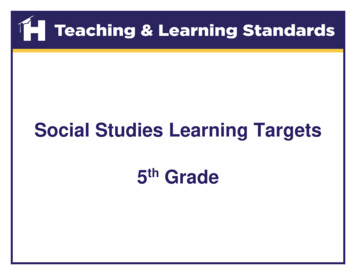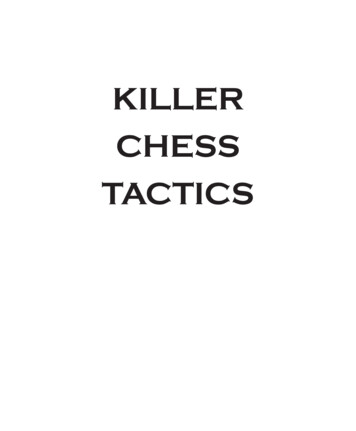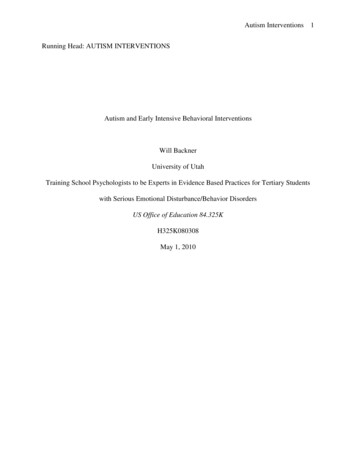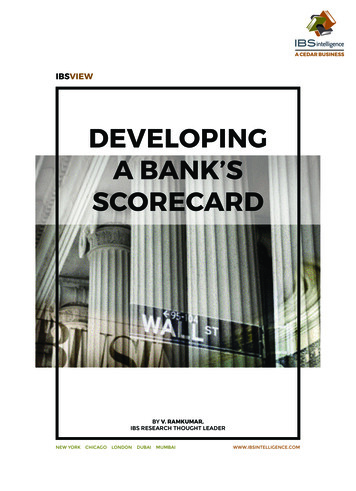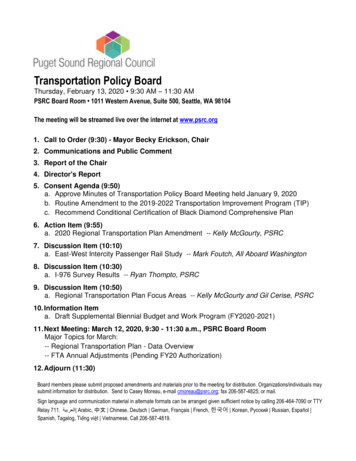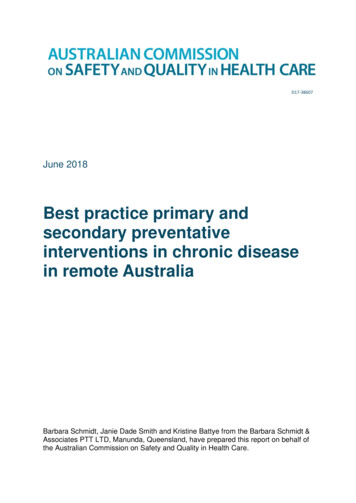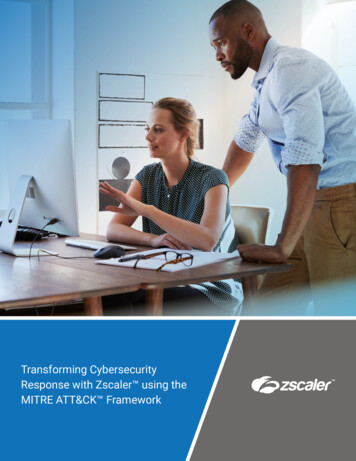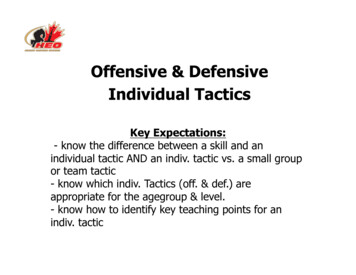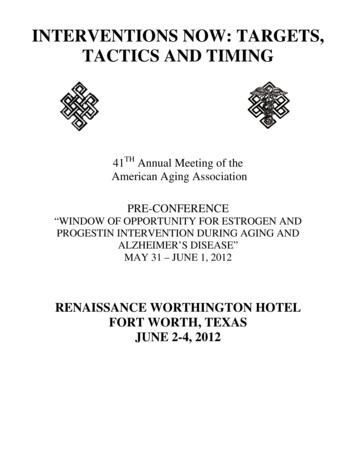
Transcription
INTERVENTIONS NOW: TARGETS,TACTICS AND TIMING41TH Annual Meeting of theAmerican Aging AssociationPRE-CONFERENCE“WINDOW OF OPPORTUNITY FOR ESTROGEN ANDPROGESTIN INTERVENTION DURING AGING ANDALZHEIMER’S DISEASE”MAY 31 – JUNE 1, 2012RENAISSANCE WORTHINGTON HOTELFORT WORTH, TEXASJUNE 2-4, 2012
SCHEDULE AT A GLANCEBRAZOS/CORRIDOR BALLROOM8:45 AM – 9:00 AMOPENING REMARKSFRIDAYJUNE 1, 2012PRE-PROGRAM9:00 AM – 11:00 AMTHE CLINICAL EFFECTS OF HORMONES IN POST-MENOPAUSALWORMEN11:00 AM – 12:30 PMLUNCH ON YOUR OWN12:30 PM – 3:00 PMTHE EFFECTS OF HORMONES ON COGNITIVE DECLINE IN RODENTMODELS3:00 PM – 3:30 PMBREAK3:30 PM – 5:30 PMPOTENTIAL MECHANISM(S) OF THE LOSS OF EFFECTIVENESS OFHORMONE WITH TIME AFTER THE MENOPAUSE?PECOS BALLROOM8:30 AM – 9:30 AMKEYNOTE ADDRESS: RAJINDAR S. SOHAL9:30 AM – 10:10 AMOXIDATIVE STRESS: AN EVOLVING CONCEPT10:10 AM – 10:40 AMBREAKSATURDAYJUNE 2, 201210:40 AM – 11:40 AMOXIDATIVE STRESS: AN EVOLVING CONCEPT CONT.11:40 AM – 1:00 PMINTERVENTIONSNOW: TARGETS,TACTICS ANDTIMINGBRAZOS/CORRIDOR BALLROOMVINCENT CRISTOFALO AWARD LUNCHEONVINCENT CRISTOFALO AWARD LECTURE1:00PM - 3:40 PMPECOS II BALLROOMPECOS I BALLROOMNEW INVERTEBRATES INARTHUR BALIN SESSIONAGING RESEARCH3:40 PM – 4:00 PMBREAK4:00 PM – 5:15 PMPECOS II BALLROOMPECOS I BALLROOMSUBMITTED PAPERS – 3ASUBMITTED PAPERS – 3B5:30 PM – 7:00 PMBALLROOM FOYERCOCKTAIL RECEPTION AND POSTER SESSION I
PECOS BALLROOM8:00 AM – 10:00 AMTHERAPEUTIC TARGETS FOR HEALTH SPAN AND LIFESPANEXTENSION10:00 AM – 10:30 AMBREAK10:30 AM – 12:30 PMADVANCES IN NUTRIENT MODULATION OF AGINGSUNDAYJUNE 3, 2012INTERVENTIONSNOW: TARGETS,TACTICS ANDTIMING12:30 PM – 2:00 PMBRAZOS/CORRIDOR BALLROOMAWARDS LUNCHEON ANDDENHAM HARMAN AWARD LECTURE2:00 PM – 4:00 PMPECOS II BALLROOMPECOS I BALLROOMSENSORY AND ORGAN SYSTEMS:TRANSATLANTICIMPROVING THE AGINGSYMPOSIUMEXPERIENCE4:00 PM – 4:30 PMBREAKPECOS BALLROOM4:30 PM – 5:30 PMPLENARY SESSION: JAMES JOSEPH ADDRESSROBERT KRIKORIAN6:00 PM – 6:30 PMAGE BUSINESS MEETING5:30 PM – 7:00 PMBALLROOM FOYERCOCKTAIL RECEPTION AND POSTER SESSION IIMONDAYJUNE 4, 2012PECOS BALLROOM8:00 AM – 10:00 AMEATING AND AGING10:00 AM – 10:30 AMBREAKINTERVENTIONSNOW: TARGETS,TACTICS ANDTIMING10:30 AM – 12:35 PMPECOS II BALLROOMPECOS I BALLROOMNATHAN SHOCK CENTERSTARTING WHEN? TIMING OFSYMPOSIUMANTI-AGING INTERVENTIONS12:35 PM – 1:00 PMAWARDS CEREMONY FOR TRAINEES
TABLE OF CONTENTSAcknowledgments.1Conference Program.9Poster Session outline.21Award Presentation Abstracts . . . . . . . . . . . . . . . . . . . . . . . . . . . . . . . . . . . . . . .27Session Abstracts.29Poster Session Abstracts.60Membership Directory.94
ACKNOWLEDGEMENTSThe American Aging Association and the College of Clinical Gerontology are grateful to the followingsponsors for support of this conference as well as grant support from the National Institute of Aging.Their generous contributions have enabled us to continue a tradition of offering an excellent program ofpertinent topics presented by speakers renowned in their fields, providing valuable mentoringopportunities for junior investigators and scholarships for students.National Institute on AgingGlenn Foundation for Medical ResearchThe Ellison Medical FoundationAmerican Federation for Aging ResearchThe SENS FoundationThe Gerontological Society of AmericaBritish Society for Research on AgeingWild Blueberry Association of North AmericaSpringer Science & Business MediaAging Research NetworkThe Buck Institute for Research on AgingInstitute for Aging and Alzheimer’s Disease ResearchUNTHSC Preventable Aging Foundation1
NATIONAL INSTITUTES OF HEALTH / NATIONAL INSTITUTE ON AGINGOverviewThe National Institute on Aging (NIA), one of the 25 institutes and centers of the National Institutes ofHealth, leads a broad scientific effort to understand the nature of aging and to extend the healthy, activeyears of life. In 1974, Congress granted authority to form the National Institute on Aging to provideleadership in aging research, training, health information dissemination, and other programs relevant toaging and older people. Subsequent amendments to this legislation designated the NIA as the primaryfederal agency on Alzheimer’s disease research.MissionThe NIA’s mission is to improve the health and well-being of older Americans through research, andspecifically to:Support and conduct high quality research on:-aging processes-age-related diseases-special problems and needs of the agedTrain and develop highly skilled research scientists from all population groupsDevelop and maintain state-of-the-art resources to accelerate research progressDisseminate information and communicate with the public and interested groups on health and researchadvances and on new directions for research.ProgramsNIA sponsors research on aging through extramural and intramural programs. The extramural programfunds research and training at universities, hospitals, medical centers, and other public and privateorganizations nationwide. The intramural program conducts basic and clinical research in Baltimore, MD,and on the NIH campus in Bethesda, MD.www.nia.nih.gov2
PLATINUM SPONSORThe purpose of the foundation, which was founded in 1965 by Paul F. Glenn, is to extendthe healthy productive years of life through research on the mechanisms of biologicalaging.www.glennfoundation.orgPLATINUM SPONSORThe Ellison Medical FoundationThe Ellison Medical Foundation supports basic biomedical research on aging relevant tounderstanding lifespan development processes and age-related diseases and disabilities.The Foundation particularly wishes to stimulate new, creative, research that might not be fundedby traditional sources or that is often under-funded in the U.Swww.ellisonfoundation.org3
GOLD SPONSORFor 31 years, the American Federation for Aging Research (AFAR) has been at the forefrontof this revolutionary approach to the science of healthier aging. AFAR has played a majorrole in providing and advancing knowledge of aging and mechanisms of age-related diseaseby providing grants totaling more than 132 million in support of researchers in aging and toencourage the training of new scientists and physicians. To learn more about AFAR, visit ourwebsite www.afar.org. We also invite you to visit our web site InfoAging.org for the latestinformation on the biology of aging, common diseases of aging and healthy lifestyles.www.afar.orgGOLD SPONSORhttp://www.sens.orgSENS Foundation works to develop, promote and ensure widespread access to rejuvenationbiotechnologies which comprehensively address the disabilities and diseases of aging. TheFoundation catalyses progress toward a comprehensive panel of rejuvenation biotechnologiesthrough its growing global networks and collaborations, and through key research projects,executed in its own Research Center and numerous affiliated universities, research organizationsand other centers of excellence.4
GOLD SPONSORBSRABritish Society for Research on AgeingThe British Society for Research on AgeingThe British Society for Research on Ageing (BSRA) promotes research to understand thecauses and effects of the ageing process. BSRA encourages publication and publicunderstanding of ageing research, publishes its own journal "Lifespan", a monthly electronicnewsletter and holds an annual scientific meeting.www.bsra.org.uk/index.htmlSILVER SPONSORWild Blueberry Association of North Americahttp://www.wildblueberries.com5
SILVER SPONSORSILVER SPONSORThe goal of the IAADR of the University of North Texas Health Science Center is to serve as afocal organization for leadership in all aspects of research and education into the causes,prevention and treatment of age-related conditions that afflict our population. This goal isachieved through interdisciplinary programs of basic biomedical research, translational research,and clinical studies into the early diagnosis, prevention, and treatment of age-related conditions.The Institute plays an active leadership role in the dissemination of this new knowledge tostudents, health care professionals and to the lay public.http://www.hsc.unt.edu/research/IAADR/6
EXHIBITORSTUDENT AWARD DONATIONAgeNet (Aging Research Network), is a Canadian charity whose mission is help historicallydisparate scientific disciplines realize synergies and develop interventions in degenerativedisease through funding research and educationSTUDENT AWARD DONATIONThe Gerontological Society of America is the oldest and largest multidisciplinary scientificorganization devoted to the advancement of aging research. Its membership includes more than5,000 researchers, educators, practitioners, and other professionals. The Society's principalmission is to promote research and education in aging and to encourage their dissemination toothers.7
STUDENT AWARD DONATIONPreventable Aging FoundationThe mission of the Preventable Aging Foundation is to promote research on mechanisms ofbiological aging and to facilitate discovery of chemical, nutritional and lifestyle strategies thatenhance health and quality of life during aging.MEMBERSHIP DONATIONS 2012GENERAL DONORSDonald IngramHolly Brown-BorgRochelle BuffensteinGregory FahyMichael ForsterDonna HolmesDavid SlateJAMES A. JOSEPH/ MARK A. SMITH MEMORIAL FUNDMarlene JosephPeggy HarrisRESEARCH FUNDElliot BergmanIan RossStudent Travel AwardsMike Anson8
Thursday, May 31, 2012 Pre-MeetingUNT Health Science Center, Medical Education and Training (MET) Bldg., rm. 109/110/1111000 Montgomery St., Fort Worth“WINDOW OF OPPORTUNITY FOR ESTROGEN AND PROGESTININTERVENTION DURING AGING AND ALZHEIMER’S DISEASE”Chairs: Meharvan Singh and James W. Simpkins12:30 pm – 2:00 pmShuttle service from Worthington Hotel to UNTHSC1:00 pm – 3:00 pmPre-Conference Registration (UNTHSC, MET 109/110/111)3:00 pm – 6:00 pmPREDOCTORAL FINALIST SYMPOSIUMChair: Heather Bimonte-Nelson, Arizona State University, Phoenix, AZ3:00 pm – 3:15 pm1. Erin Scott, Georgia Health Sciences University, Augusta, GALong-Term Estrogen Deprivation Disrupts Pro-Survival Wnt/β-CateninSignaling in the CA1 Hippocampal Region3:20 pm – 3:35 pm2. Timothy Richardson, University of North Texas Health Science Center, Fort Worth, TXEstrogen Cytoprotection in Friedreich’s Ataxia via an Antioxidant Mechanism3:40 pm – 3:55 pm3. Elizabeth Engler-Chiurazzi, Arizona State University, Phoenix, AZDon’t Overthink it: Cognitive Benefits of Premarin Depend on TaskComplexity in a Rodent Model of Surgical-Menopause4:00 pm – 4:15 pm4. Jazmin Acosta, Arizona State University, Phoenix, AZCEE Exerts Differential Effects on Cognition Depending on Menopause Type:Relation with Androstenedione-Induced Impairments4:15 pm – 4:45 pm4:45 pm – 5:00 pmBREAK5. Sarah Mennenga, Arizona State University, Phoenix, AZEstrone Treatment Impairs Memory and Does Not Impact Number of BasalForebrain Cholinergic Neurons in the Middle-Aged Rat5:05 pm – 5:20 pm6. Akram Sidhu, University of North Texas Health Science Center, Fort Worth, TXEffects of Short-Term Phytoestrogen Supplementation on Motor Performanceof Male and Female Mice5:25 pm – 5:40 pm7. Brittany Branden, Arizona State University, Phoenix, AZCognitive-Impairing Effects of Medroxyprogesterone Acetate in the Rat:Independent and Interactive Effects across Time5:45 pm – 6:00 pm8. Nioka Chisholm, University of Illinois Urbane-Champaign, Urbana, ILLong-Term Estrogen and Medroxyprogesterone Acetate Alters Synapses andTyrosine Hydroxylase in the Aging Prefrontal Cortex6:15 pmShuttle service to Worthington Hotel from UNTHSC6:45 pmShuttle service to Joe T. Garcia’s restaurant from Worthington Hotel7:00 pmDINNER (Joe T. Garcia’s) http://www.joets.comShuttle service to Worthington Hotel or Fort Worth Stockyards9
Friday June 1, 2012Pre-Meeting (WORTHINGTON RENAISSANCE HOTEL)“WINDOW OF OPPORTUNITY FOR ESTROGEN AND PROGESTININTERVENTION DURING AGING AND ALZHEIMER’S DISEASE”Chairs: Meharvan Singh and James W. Simpkins8:00 am – 8:45 amPre-Conference Registration and Continental Breakfast at Worthington Hotel8:45 am – 9:00 amWelcome and Opening RemarksJames Simpkins, PhD, University of North Texas Health Science Center at Fort Worth,Fort Worth, TX9:00 am – 11:00 amSESSION ITHE CLINICAL EFFECTS OF HORMONES IN POSTMENOPAUSAL WOMENChair: Meharvan Singh, PhD, University of North Texas Health Science Center at FortWorth, Fort Worth, TX9:00 am – 9:30 am9. Pauline M. Maki, PhD, University of Illinois School of Medicine, Chicago, ILA Scientific Update on the Critical Window Hypothesis: Evidence fromRandomized Controlled Trials of Hormone Therapy9:30 am – 10:00 am10. Mark Espeland, PhD, Wake Forest University Health Sciences, Winston-Salem, NCThe Women’s Health Initiative Memory Study of YoungerWomen (WHIMS-Y): Rationale, Design, and Preliminary Data10:00 am – 10:30 am11. Sanjay Asthana, MD, University of Wisconsin School of Medicine, Madison, WICognition and Alzheimer’s Disease: Potential Role of Perimenopausal HormoneTherapy10:30 am – 11:00 am12. Jane Wigginton, MD, University of Texas Southwestern Medical School, Dallas, TXEstrogens in Traumatic Brain Injury: A NIFTI Way to RESCUE Patients11:00 pm – 12:30 pm12:30 pm – 3:00 pmLUNCH BREAK (on your own)SESSION IITHE EFFECTS OF HORMONES ON COGNITIVE DECLINE INRODENT MODELSChair: Roberta Brinton, PhD, University of Southern California, Los Angeles, CA12:30 pm – 1:00 pm13. Heather Bimonte-Nelson, PhD, Arizona State University, Tempe, AZGot Hormones? Estrogens, Progestins and Memory During Aging in the RatModel1:00 pm – 1:30 pm14. Philip W. Landfield, PhD, University of Kentucky, Lexington, KYThe Complex Role of Glucocorticoids in Aging-Related Decline of Memory10
1:30 pm – 2:00 pm15. Martin Kelly, PhD, Oregon Health Sciences University, Portland, ORA Selective Membrane Estrogen Receptor Agonist Maintains AutonomicFunctions in Hypoestrogenic States2:00 pm – 2:30 pm16. ShaoHua Yang, MD, PhD, University of North Texas Health Science Center at FortWorth, Fort Worth, TXFunction of Estrogen Receptor Beta as a Mitochondrial Component2:30 pm – 3:00 pm17. Derek Schreihofer, PhD, University of North Texas Health Science Center at Fort Worth,Fort Worth, TXEstrogen Receptors: Who, Where and When3:00 pm – 3:30 pm3:30 pm – 5:30 pmBREAKSESSION IIIPOTENTIAL MECHANISM(S) OF THE LOSS OF EFFECTIVENESSOF HORMONE WITH TIME AFTER THE MENOPAUSE?Chair: Farida Sohrabji, PhD, Texas A&M University Health Science Center, Bryan, TX3:30 pm – 4:00 pm18. Farida Sohrabji, PhD, Texas A&M University Health Science Center, Bryan, TXBioavailability of IGF-1 Determines if Estrogen is Neuroprotective orNeurotoxic4:00 pm – 4:30 pm19. Roberta Brinton, PhD, University of Southern California, Los Angeles, CABioenergetic of Reproductive Senescence: Implications for Risk of Alzheimer’sDisease4:30 pm – 5:00 pm20. Darrell W. Brann, PhD, Georgia Health Sciences University, Augusta, GAEstrogen and the Risk of Dementia and Mortality to Neurological Disease5:00 pm – 5:30 pm21. Meharvan Singh, PhD, University of North Texas Health Science Center at Fort Worth,Fort Worth, TXProgesterone, BDNF and Neuroprotection5:30 pm- 6:00 pmSESSION IVGENERAL DISCUSSIONChairs: Meharvan Singh, PhD and James W. Simpkins, UNT Health Science Center at FortWorthThe meeting will end with a discussion of the issues on which there was consensus as well asthose on which there was controversy or too little scientific data to draw any conclusions.Additionally, a discussion on the direction of clinical and basic science research needed toresolve the remaining issues in the “Window of Opportunity” will occur.PRE-CONFERENCE ADJOURNS6:30 pm – 8:30 pm11AAA Conference RegistrationAAA WELCOME RECEPTION
Saturday June 2, 2012 Meeting (WORTHINGTON RENAISSANCE HOTEL)INTERVENTIONS NOW: TARGETS, TACTICS AND TIMINGChair: Michael J. Forster, PhDUniversity of North Texas Health Science Center at Fort Worth7:15 amContinental Breakfast8:15 am – 8:30 amWelcome and Opening RemarksMichael Forster, PhD, University of North Texas Health Science Center at FortWorthPresident, American Aging Association8:30 am – 9:30 amKeynote Address:Rajindar S. Sohal, PhDUniversity of Southern California, Los Angeles, CAFrom Oxidative Damage to Redox Stress: Evolution of a Concept9:30 am – 11:40 amSession IOXIDATIVE STRESS: AN EVOLVING CONCEPTChair: William C. Orr, PhD, Southern Methodist University, Dallas, TX9:30 am – 9:35 amWilliam C. Orr, PhD, Southern Methodist University, Dallas, TXIntroductory Remarks9:35 am – 10:05 am22. Henry J. Forman, PhD, University of California, Merced, CASignaling by Peroxides and Alkylating Agents - How Specific Thiols areTargeted10:05 am – 10:35 amBREAK10:35 am – 11:05 am23. Pamela Maher, PhD, Salk Institute, La Jolla, CAFunctional Consequences of Age-Dependent Changes in GSH Status in the CNS11:05 am – 11:40 am24. Malcolm J. Jackson, University of Liverpool, UKDefective Redox Signaling and Age-Related Loss of Skeletal Muscle11:40 am –1:00 pmVincent Cristofalo Memorial Rising Star Award and LectureSponsorsThe American Federation of Aging Research (AFAR)Margaret F. CristofaloAnne Brunet, PhDStanford University, Stanford, CAThe Plasticity of Aging12
1:00 pm – 3:40 pmSession II-A and II-B are Dual SessionsSESSION II-ANEW INVERTEBRATES IN AGING RESEARCHChairs: Mahadev Murthy, PhD and Nancy Nadon, PhD, National Institute on AgingSPONSORED BY: NATIONAL INSTITUTE ON AGING1:00 pm – 1:20 pm25. Steven N. Austad, PhD, Barshop Institute, San Antonio, TXAging in Hydra, Loss of Stemness1:20 pm – 1:40 pm26. Diane Bridge, PhD, Elizabethtown College, Elizabethtown, PAInducible Aging in Hydra1:40 pm – 2:00 pm27. Anthony W. De Tomaso, PhD, University of California, Santa Barbara, CAAging and Regeneration in the Basal Chordate, Botryllus schlosseri2:00 pm – 2:20 pm28. Ayelet Voskonoynik, PhD, Stanford University, Stanford, CAFirst Draft of Botryllus schlosseri Genome, a Clonal Invertebrate with aProgrammed Lifespan2:20 pm – 2:40 pm29. William R. Jeffery, PhD, University of Maryland, College Park, MDThe Tunicate Ciona: A New Model for Studying Age-related Decay inRegenerative Capacity and Tissue Repair2:40 pm –3:00 pm30. David Mark Welch, Marine Biological Laboratory, Woods Hole, MAComparative Biology and Genomics of Aging in Rotifers3:00 pm – 3:20 pm31. Jeffry L. Dudycha, PhD, University of South Carolina, Columbia, SCDaphnia: A Model Crustacean for Genetic Variation of Aging3:20 pm – 3:40 pm32. Irv Weissman, MD, Stanford University, Stanford, CATBASESSION II-BTRANSLATION IN ACTION: RECENT ADVANCES(ARTHUR BALIN SESSION)Chair: Mohsen Meydani, Jean Mayer USDA HNRCA at Tufts University andJanko Nikolich-Zugich, University of Arizona College of MedicineSPONSORED BY: THE GLENN FOUNDATION1:00 pm – 1:30 pm33. Jörg Goronzy, MD, PhD, Stanford University, Stanford, CAT Cell Metabolism and Signaling in Aging – Friends or Foes?1:30 pm – 2:00 pm34. Emran Mayer, MD, University of California Los Angeles, Los Angeles, CAFrontiers in Enteric Neuroscience2:00 pm – 2:30 pm35. Sarah Booth, Jean Mayer USDA HNRCA at Tufts University, Boston, MANutrients and Bone Health: Evidence for Additional Role in Heart Health2:30 pm – 3:00 pm36. Roger Fielding, PhD, Jean Mayer USDA HNRCA at Tufts University, Boston, MATranslational Approaches to Clinical Trials of Nutrition and Physical Activity inOlder Adults: From Biology to Function13
3:00 pm – 3:30 pmBSRA Korenchevsky Award Presentation37. David Bartlett, BSc, MRC-ARUK Centre for Musculoskeletal Ageing Research,University of Birmingham, UKThe Age-Related Increase in Low Grade Systemic Inflammation(Inflammaging) is not Driven by Cytomegalovirus Infection3:40 pm – 4:00 pmBREAK4:00 pm - 5:15 pmSubmitted Papers Sessions III-A and III-B are Dual SessionsSUBMITTED PAPERS SESSION III-A: MITOCHONDRIA AND METABOLISM INAGINGChair: Holly Brown-Borg, PhD, University of North Dakota, Grand Forks, ND4:00 pm – 4:15 pm38. Alessandro Bitto (N), Drexel University College of Medicine, Philadelphia, PARapamycin Improves Mitochondrial Homeostasis and Delays the Onset ofSenescence by Altering p62/SQSTM1 Dynamics4:15 pm – 4:30 pm39. Nazia Alam, Weill Cornell Medical College, Burke Medical Research Institute, NewYork, NYA Novel Peptide that Improves Mitochondrial Function Reverses Diabetes – andAge-Related Visual Decline4:30 pm – 4:45 pm40. Reyhan Westbrook (N), Southern Illinois University School of Medicine, Springfield, ILThe Impact of Ambient Temperature on Metabolism in Long-Lived Mice4:45 pm – 5:00 pm41. Simon Johnson (N), University of Washington, Seattle, WAAffects and Mechanism of a Caloric Restriction Mimetic as an Intervention in aMouse Model of a Human Mitochondrial Disease5:00 pm – 5:15 pm42. George Perry, PhD, University of Texas at San Antonio, San Antonio, TXImpaired Mitochondrial Dynamics and Function Result from LRRK2Mutations4:00 pm – 5:15 pmSUBMITTED PAPERS SESSION III-B: HEALTHSPAN: CELLS, TISSUES,ORGANISMSChair: LaDora Thompson, PhD, University of Minnesota, Minneapolis, MN4:00 pm – 4:15 pm43. Ted Graber (N), University of Minnesota Medical School, Minneapolis, MNC57BL/6 Neuromuscular Healthspan Scoring System: Assessment ofSarcopenia/Frailty Interventions4:15 pm – 4:30 pm44. Yun Shi (G), University of Texas Health Science Center at San Antonio, TXCell Autonomous and Non-Autonomous Neuromuscular Phenotypes ofCuZn-SOD Knockout Mice – an Electrophysiological Study4:30 pm – 4:45 pm45. Robert Krikorian, University of Cincinnati, Cincinnati, OHConcord Grape Juice Supplementation and Neurocognitive Function4:45 pm – 5:00 pm46. Dudley Lamming (G), Whitehead Institute, Massachusetts Institute of Technology,Cambridge, MADepletion of mTORC2 Impairs the Health and Longevity of Mice14
5:00 pm – 5:15 pm47. Alexander Kulminski, Duke University, Durham, NCTrade-off in the Effect of the APOE Gene on the Ages at Onset of CVD andCancer across Ages, Gender and Human Generations5:30 pm – 7:00 pmPoster Session ICompetition for the Glenn Award and the Nicolai Prize5:30 pm – 7:00 pmCOCKTAIL RECEPTION7:00 pm – 8:30 pmSpecial Student Session7:00 pm – 10:00 pmAGE BOARD OF DIRECTORS DINNER MEETING15
Sunday June 3, 2012 Meeting (WORTHINGTON RENAISSANCE HOTEL)7:00 amContinental Breakfast8:00 am – 10:00 amSession VITHERAPEUTIC TARGETS FOR HEALTH SPAN AND LIFESPAN EXTENSIONChair: Randy Strong, PhD, Barshop Institute, University of Texas at San Antonio, SanAntonio, TXSPONSORED BY: ELLISON FOUNDATION8:00 am – 8:30 am48. William Balch, PhD, The Scripps Research Institute, La Jolla, CADecoding Proteostasis of Aging8:30 am – 9:00 am49. Richard A. Miller, MD, PhD, University of Michigan, Ann Arbor, MIAnti-Aging Drugs in Mice: Two New Ones and an Old Favorite Revisited9:00 am – 9:30 am50. William C. Orr, PhD, Southern Methodist University, Dallas, TXPeroxiredoxins and Redox-Sensitive Signaling in Aging9:30 am – 10:00 am51. Gordon Lithgow, PhD, Buck Institute, Novato, CANatural Products that Suppress Protein Aggregation and Slow Aging10:00 am – 10:30 am10:30 am – 12:40 pmBREAKSession VADVANCES IN NUTRIENT MODULATION OF AGINGChair: Barbara Shukitt-Hale, PhD, Jean Mayer USDA HNRCA at Tufts University, Medford,MASPONSORED BY: THE GLENN FOUNDATION10:30 am – 11:00 pm52. Paula Bickford, PhD, University South Florida and VAMC, Tampa FLNutritional Interventions and Stem Cell Senescence11:00 am – 11:30 pm53. Greg Cole, University of California Los AngelesSupplements and Alzheimer's11:30 am – 12:00 pm54. Nathalie Sumien, PhD, University North Texas Health Science CenterTiming of Antioxidant Intervention Affects Functional Outcome in Aged Mice12:00 pm – 12:15 pm55. Shibu Poulose, Jean Mayer USDA, HNRCA at Tufts UniversityProtective Effects of Berries on Brain Against Radiation-Induced TauHyperphosphorylation and Ubiquitin Aggregates (abstract #141)12:15 pm – 12:30 pm55-A. Barbara Shukitt-Hale, PhD, Jean Mayer USDA, HNRCA at Tufts UniversityNutritional Interventions in Mobility and Cognition in Aging12:30 pm – 12:40 pmSpecial Presentation:Felipe Sierra, National Institute on Aging and Dan Perry, Alliance for Aging ResearchBrief Update on Trans-NIH Coordination of Aging Research16
12:40 pm – 2:00 pmAMERICAN AGING ASSOCIATION AWARDS LUNCHEON(ALL ATTENDEES ARE INVITED TO ATTEND)Awards Presentations:Denham Harman Award1:00 pm – 2:00 pmPLENARY SESSION: DENHAM HARMAN AWARD LECTUREJames W. Simpkins, PhDUniversity of North Texas Health Science Center, Fort Worth, TXWandering in Aging Research: A Life of Running Against the WindSESSION VI-A AND VI-B ARE DUAL SESSIONS2:00 pm – 4:00 pmSession VI-ASENSORY AND ORGAN SYSTEMS: IMPROVING THE AGINGEXPERIENCEChairs: Christian Leeuwenburgh, PhD and Shinichi Someya, PhD, University of Florida2:00 pm –2:30 pm56. Norm Wolf, DVM, PhD, University of Washington, Seattle, WACell Cycling Suppression in a Set of Lens Epithelium Cells2:30 pm – 3:00 pm57. Shinichi Someya, PhD, University of Florida, Gainesville, FLCaloric Restriction, Sirt3, and Age-Related Hearing Loss in Mice3:00 pm – 3:30 pm58. Scott Pletcher, PhD, University of Michigan, Ann Arbor, MIMolecular Dissection of Sensory Modulation of Lifespan in Drosophila3:30 pm – 4:00 pm59. Debapriya Dutta, BS, and Christian Leeuwenburgh, PhD, University of Florida,Gainesville, FLAutophagy Induction with Life-Long and Late-Onset Interventions2:00 pm – 4:00 pmSession VI-BTRANSANTLANTIC SYMPOSIUMChair: Richard Faragher, PhD, Brighton University, UK2:00 pm –2:20 pm60. Nancy Manley, PhD, University of Georgia, Athens, GA and Claire Blackburn, PhD,University of Edinburgh, Edinburgh, UKSteroid Receptors and the Control of Thymic Involution2:20 pm – 2:40 pm61. Brian Kennedy, PhD, Washington University, Seattle, WA and Dominic Withers,Imperial College, London, UKS6 Kinase, Aging and Age-Related Disease2:40 pm – 3:00 pm62. Dhaval Patel, PhD, King’s College London, UK and Mei Zhan, PhD, Georgia Institute ofTechnology, Atlanta, GASources, Transmission and Effects of Transcriptional Noise in C. elegans Aging3:00 pm –3:20 pm63. Arne Akbar, PhD, University College London, London, UK and Janko Nikolich-Zugich,MD, PhD, University of Arizona, Tucson, AZMechanisms of Reduced T Cell Immunity in Older Adults17
3:20 pm –3:40 pm64. John Sedivy, PhD, Brown University, Providence, RI and Peter Adams, MD, BeatsonInstitute for Cancer Research, University of Glasgow, Glasgow, UKThe WNT-Chromatin Axis in Aging3:40 pm –4:00 pm65. Iain Ridgway, MD, University of Bangor, UK and Steven Austad, PhD, University ofTexas Health Science Center San Antonio, TXMechanisms of Exceptional Longevity in the World’s Longest Lived Animal4:00 pm – 4:30 pmBREAK4:30 pm – 5:30 pmPLENARY SESSION VII: JAMES JOSEPH ADDRESSRobert Krikorian, PhDUniversity of Cincinnati, Cincinnati, OHNutritional Interventions in Cognitive Aging(Sponsored by: James Joseph and Mark Smith memorial fund, American Aging Association)6:00 pm – 6:30 pmAAA Business Meeting – Open to all members6:30 pm – 8:00 pmPOSTER SESSION 2Competition for Glenn Award and Nicolai Prize6:30 pm – 8:00 pmCOCKTAIL RECEPTION18
Monday, June 4; Meeting (WORTHINGTON RENAISSANCE HOTEL)7:00 amContinental Breakfast8:00 am – 10:00 amSESSION VIII: EATING AND AGINGChair: Donald Ingram, PhD, Pennington Biomedical Research Center, Baton Rouge, LA8:00 am – 8:30 am66. Eric N. Reither, PhD, Utah State University, Logan, UTObesity in America: Implications for Aging and Longevity8:30 am – 9:00 am67. Phil Scarpace, PhD, University of Florida, Gainesville, FLAnorexic Behaviors with Age: Influence of Leptin and Exercise9:00 am – 9:30 am68. Mohsen Meydani, DVM, PhD, Jean Mayer USDA HNRCA at Tufts University, Boston,MANutritional Modulation of Aging: Nutrients and Bioactive Compounds9:30 am – 10:00 am69. Martha C. Morris, ScD, Rush University Medical Center, Chicago, ILNutritional Risk Factors and Interventions for Brain Aging andAlzheimer’s Disease10:00 am -10:30 amBREAK10:30 am -12:35 pmSESSION IX-A AND IX-B ARE DUAL SESSIONSSESSION IX-A: NATHAN SHOCK CENTER SYMPOSIUMChair: Felipe Sierra, National Institute on Aging10:30 am – 10:55 am70. Veronica Galvan, PhD, UTHSCSA Barshop Institute on Aging, San Antonio, TXTOR as a Regulator of Brain Aging: Studies of a Vascular Function in a MouseModel of Alzheimer’s Disease.10:55 am – 11:20 am71. Richard A. Miller, MD, PhD University of Michigan, Ann Arbor, MIA Shared Molecular Signature for Slow Aging in Mice11:20 am – 11:45 am72. David J. Marcinek, PhD, University of Washington, Seattle, WAAcute Pharmacological Intervention Reverses Mitochondrial Deficits andImproves Function in Aged Skeletal Muscle11:45 am – 12:10 pm73. Jill P. Crandall, MD, Albert Einstein College of Medicine, Bronx, NYResveratrol: Therapy for Age-Related Insulin Resistance and GlucoseIntolerance?12:10 pm – 12:35 pm74. Ron Korstanje, PhD, The Jackson Laboratory, Bar Harbor, MEStudying Aging and Kidney Decline Using Human, Mouse, Zebrafish, andWorms19
SESSION IX-B: STARTING WHEN? TIMING OF ANTI-AGING INTERVENTIONSChair: Aubrey de Grey, SENS Foundation10:30 am – 10:55 am75. Christy S. Carter, PhD, University of Florida, Gainesville, FLBehavior as a Tool for Assessing the Efficacy of Late Life Interventions forCombating Aging10:55 am – 11:20 am76. Donald K. Ingram, PhD, Pennington Biomedical Research Center, Baton Rouge, LALate – Life Calorie Restriction in Rhesus Monkeys11:20 am – 11:45 am77. Sudhir Paul, University of Texas Houston, Houston, TXBeneficial Catalytic Autoimmunity to Amyloids Amplified with Age11:45 am – 12:10 pm78. Gouri Yogalingam, SENS Foundation, Mountain View, CATowards a Therapeutic Intervention for Age-Related Macular Degeneration12:10 pm – 12:35 pm79. Matthew O’Conner, PhD, SENS Foundation, Mountain View, CAMitoSENS: Allotopic Expression of Mitochondrial Genes Using a CoTranslational Import Strategy12:45 pm – 1:15 pmAWARDS CEREMONY1:15 pmMEETING ADJOURNS20
Poster Session ISaturday,
Develop and maintain state-of-the-art resources to accelerate research progress . . 1000 Montgomery St., Fort Worth . Institute for Cancer Research, University of Glasgow, Glasgow, UK . The WNT-Chromatin Axis in Aging . 3:40 pm -4:00 pm 65. Iain Ridgway, MD, University of Bangor, UK and Steven Austad, PhD, University of
